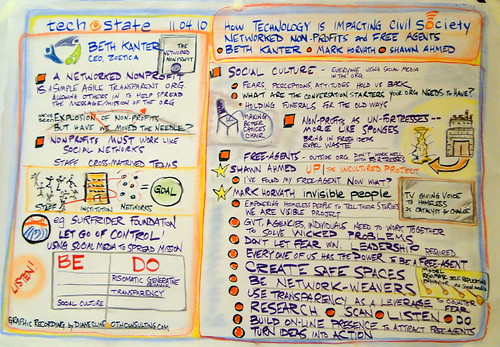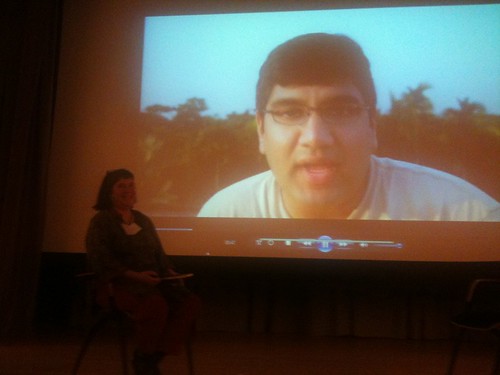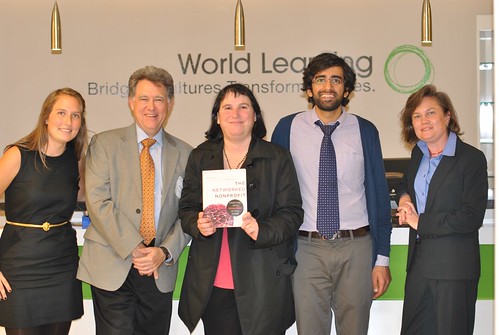
Last week, I was honored to facilitate a “networked discussion” about the Networked Nonprofit and working with free agents in Washington, DC at the State Department’s “Tech@State Civil Society 2.0” Event.

Joining me were two of my favorite free agents, Mark Horvath (next to me on stage) and Shawn Ahmed (virtually through Twitter #netnon hashtag and video). My goal was to have a conversation with the folks in the room – who represented both traditional nonprofit institutions, government agencies, and free agents – and answer the question, “I’ve found my free agent now what?”
My session was part of the third edition of Tech@State, held on, November 4th & 5th in collaboration with The World Bank. The sold out event was also streamed live here. This Tech@State addressed Secretary of State Hillary Clinton’s Civil Society 2.0 initiative.
I started with an overview of the Networked Nonprofit and shared some thoughts about social cultures and transparency — referencing the models in our book – The Fortress and The Sponge. I introduced the concept of Free Agents who are smashing into the walls of fortress nonprofits and talked about how that situation is slowly changing.
Free agents are powerful social change players. A free agent is a person (many times a GenY, but not always) who is a passionate about a social cause, but is working outside of a nonprofit organization to organize, mobilize, raise money, and engage with others. Free agents are also fluent in social media and take advantage of the social media tool set to do everything organizations have always done, but outside of institutional walls. Some times they go on to form their own nonprofits like Amanda Rose and Manny Hernandez and like Mark Horvath has for his Invisible People and WeAreVisible project.
Someone in the audience asked about the ecosystem of Free Agents. It got me thinking. Free Agents can be any citizen in any country in the world, whether famous or unknown, with significant wealth or not. These are people who want to give their money, time, or personal endorsements to a cause or organization that can help solve wicked problems facing our world today.
Our society has focused on growing individual institutions ever larger and has failed to address complex social problems that outpace the capacity of any single individual or institution to solve them. That’s why nonprofits need to work more like networks than single isolated entities and connect with these good-hearted people who are fluent with social media and passionate about change.
Of all the social media for social good trends that are impacting the way nonprofits do their work, I find free agents most compelling. And, what’s exciting the ecosystem of free agents operating today.
But as Mark Horvath pointed out in his remarks and (we’ve had many discussions about this issue), he and his work has not always been greeted with open arms and an invitation to lunch by nonprofit homeless agencies or government entities. In fact, he’s been told in no uncertain terms to get out of their community! Fortunately, that’s not true for every agency Mark has approached. He says, “I wish I had a mood ring so I could determine whether it was worth my time and it comes down to leadership.”
While he often describes himself as “pushy and will scream loud to end poverty,” he knows how to establish relationships and gain trust before sharing ideas. As Mark noted, “I always approach nonprofits with a sense of grace and humility. And, I don’t tweet the names of those who don’t want to work with me because in the end it could doesn’t do anything good for our cause.”
One of the questions we got was about scaling, “How do you scale your cause beyond your work?” Free Agents need to build a network around their cause, not their name. I referenced the point made by the speaker before us, Tim O’Reilly, that being “generative” is important. I like to use June Holley’s term, “Being Rhizomatic” – essentially get people to work in small groups to carry the work forward. Mark gave this wonderful example about the five-dollar airplane.
Shawn Ahmed sent us a video from Bangladesh with his reflections on how nonprofits can work with Free Agents. Please take five minutes to watch the video – it’s excellent. He made a great point that social media expertise isn’t the only thing that free agents bring to a partnership with an NGO. For example, in Bangladesh, people mistrust nonprofits, but they are more open to individuals. So, Shawn is able to build bridges for the nonprofit and the local community because of the trust.
Shawn points to the three pillars of success for nonprofits and free agents:
1 -Hear us out! You need to listen to free agents or at least hear what they have to say.
2 -Cultivate Allies for Free Agents: As an outsider, Free Agents should NOT have to navigate the internal politics.
3 -Ideas Into Action: In the end, planning meetings need to turn into action.
He shared his experience working with three different nonprofits – some successful, some not.

The day before, I was lucky enough to spend my time doing workshops with the staff at World Learning as well as a public presentation about The Networked Nonprofit. During the Q/A, I got a lot new insights about a different type of organizational culture issue that is emerging in nonprofits related to social media – but I’ll leave that for another blog post.
I left Washington, DC to arrive back in the Bay Area to present some initial research findings at the Society of New Communications Research (blog post forthcoming) and accept an award on behalf of the Zoetica team for the awesome work we did with the Red Cross on the Emergency Data Summit (a blog post forthcoming)
What are your questions about nonprofits and free agents? What’s keeping your nonprofit back from working with a free agent? If you’re a free agent, how have you established the three pillars of success that Shawn outlines in his video?
